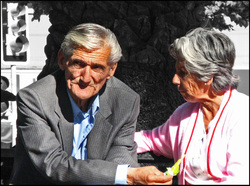 The New York Times seems to think so. A recent health article gives many good common sense tips on how to avoid back problems. However, the conclusion of the Times article seems to be that no matter how well you take care of your back, you're going to end up with degeneration. In their own words: "Some back problems, of course, can’t be avoided. Over time, spinal vertebrae naturally degenerate and spinal facets become inflamed, causing stress and discomfort." Is that true? Is the degenerative process a natural process that occurs in everyone? The picture to the left is an all-too-common image: a man and woman stooped with age. But just because this is a common image, it is not necessarily a natural image. When one hears the word "natural", one normally assumes that the "natural" thing is good for us. After all, we are part of nature. Natural health foods, natural shoes, natural diapers, natural backpacks, natural dog food, natural sunscreen, etc. Natural things are meant to be good for us, but we can all agree that this degeneration is not good for us: stooped posture and the associated muscular weaknesses that result from a displaced center of gravity. Also, since we are all part of nature, we assume that those things which are natural for one person ought to be natural for everyone else. But we know that not everyone ends up with stooped posture in their old age. And that brings us to Exhibit B... This amazing woman is Ernestine Shepherd. She is 74 years old. She is not stooped. One look at her abs of steel and strong shoulders will tell you everything you need to know about spinal degeneration. Spinal degeneration is not natural, but is the result of unnatural spinal dysfunction. When spinal vertebrae are fixed, subluxated, injured, wounded, or otherwise negatively impacted, only then are they subject to the process known as spinal degeneration. Spinal discs are literally fed by motion. Since they have very little direct blood flow, they only receive nutrients by the squishing motion of the vertebrae above and below them, slowly squeezing nourishing fluids to them throughout the busy day. If that motion ceases, then so does the nutrition. As the disc slowly dies, the body attempts to protect the area by building up extra bone to provide stability to the region. But rarely is the problem confined to one portion of the spine: the whole rest of the body begins to compensate for the loss of motion in the spine, causing far-reaching dysfunction and problems. Note well: I'm not encouraging everyone to become Ernestine Shepherd, who now holds a Guinness World Record as the oldest female bodybuilder. But the point is simple: maintain motion, exercise, and chiropractic analysis in your life in order to keep the spine healthy and in good shape. Don't sit for hours at a time. Walk. These things are natural. Spinal degeneration isn't.
1 Comment
7/5/2011 04:55:33 pm
I like your article about this amazing woman.. She's 74 years old and yet she looks like in the mid 30's only.. she has a healthy body and nice abs.
Reply
Your comment will be posted after it is approved.
Leave a Reply. |
Categories
All
DisclaimerUnless otherwise attributed, all content is written by Kyle Johnson, DC, of Johnson Family Chiropractic of Peoria.
All images used are under Creative Commons license. Although every effort has been made to provide an accurate description of our chiropractic care and its benefits, the information given on this website and blog is not intended to be, nor should it be interpreted as, medical advice for any condition. If you have any questions regarding your condition, you should seek the help of Dr. Johnson in person, so that he may properly assess your condition. This blog is provided by Johnson Family Chiropractic of Peoria, S.C., proudly located in Peoria, IL. |
Activator Methods | Webster Technique | Testimonials | Meet Dr. Johnson | Blog | Contact Us | ©2023 Johnson Family Chiropractic of Peoria, S.C.
3227 N. Prospect Rd.
Peoria, IL 61603
(309) 688-8773
3227 N. Prospect Rd.
Peoria, IL 61603
(309) 688-8773

 RSS Feed
RSS Feed